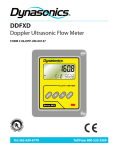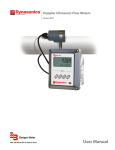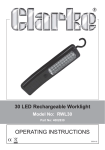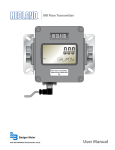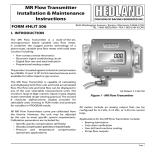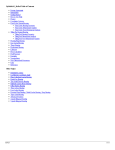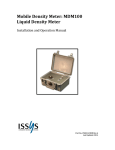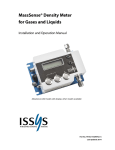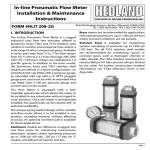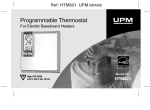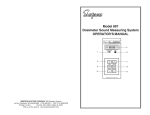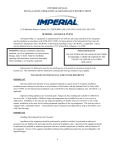Download Operator`s Manual
Transcript
Operator’s Manual RNL Insertion Style Flow Meter RWL Wafer Style Flow Meter RUN PROGRAM RELAY 1 RELAY 2 RUN PROGRAM RELAY 1 RELAY 2 WARNING TAMPERING WITH COVER WILL VOID WARRANTY CONTENTS MAY BE UNDER PRESSURE Racine Federated Inc. 8635 Washington Avenue Racine, WI 53406-3738 USA Racine is a trademark of Racine Federated Inc. Tel: 262-639-6770 RV-1004 Toll Free: 888-572-2463 TABLE OF CONTENTS PAGE INTRODUCTION.................................................................................................................................. 1 SPECIFICATIONS................................................................................................................................ 2 INSTALLATION..................................................................................................................................... 2 Mechanical Installation................................................................................................................... 2 Installation Location........................................................................................................................ 2 Flow Meter Installation.................................................................................................................... 7 Electrical Installation....................................................................................................................... 8 Flow Meter Wiring........................................................................................................................... 8 Pulse Output Line........................................................................................................................... 9 Cable Installation............................................................................................................................ 9 ±4-20 mA Terminals........................................................................................................................ 9 OPERATING THE MONITOR..............................................................................................................11 Basic Flow Programming...............................................................................................................11 Entering Programming Mode.................................................................................................. 12 ID Unit..................................................................................................................................... 12 Pipe ID.................................................................................................................................... 12 Display Function..................................................................................................................... 12 Rate Unit................................................................................................................................. 12 Rate Interval........................................................................................................................... 13 Totalizer Unit........................................................................................................................... 13 ADDITIONAL SCALING PARAMETERS............................................................................................ 13 Specific Gravity....................................................................................................................... 13 Low Flow Cutoff...................................................................................................................... 13 Damping................................................................................................................................. 13 Set 4 mA................................................................................................................................. 13 Set 20 mA............................................................................................................................... 13 20 mA Calibration................................................................................................................... 14 4 mA Adjust....................................................................................................................... 14 20 mA Adjust..................................................................................................................... 14 4-20 mA Test........................................................................................................................... 14 Password................................................................................................................................ 14 Advanced Setup..................................................................................................................... 14 Scale Factor...................................................................................................................... 15 Totalizer Pulse................................................................................................................... 15 Linearization...................................................................................................................... 15 Totalizer Functions.................................................................................................................. 16 TROUBLESHOOTING....................................................................................................................... 20 Preliminary Checks....................................................................................................................... 20 INSERTION DEPTH CALCULATION................................................................................................. 22 WARRANTY STATEMENT................................................................................................................. 30 LIST OF TABLES TABLE 1 2 3 4 5 6 7 8 TITLE PAGE Specifications.................................................................................................................................. 3 Flow Ranges................................................................................................................................... 4 Minimum Piping Requirements Line Resistance for AWG Wire Gages.......................................... 8 Line Resistance for AWG Wire Gages............................................................................................ 9 Exponent Multipliers..................................................................................................................... 13 Maximum Fluid Velocity VS Insertion Depth................................................................................. 22 Flow Profile (Raw Data)................................................................................................................ 23 Flow Profile (Normalized Data)..................................................................................................... 23 Pipe Data...................................................................................................................................... 25 FIGURE 1 2 3 4 5 6 7 8 9 10 11 LIST OF FIGURES TITLE PAGE Back Pressure Calculation........................................................................................................... 4 Outline Dimensions for RWL Series Flow Meters........................................................................ 5 Outline Dimensions for RNL Series Flow Meters........................................................................ 6 Internal Alignment of RWL Series Flow meters........................................................................... 7 Flow meter Terminal Functions.................................................................................................... 8 Load Resistance vs. Supply Voltage........................................................................................... 9 Basic Hookups........................................................................................................................... 10 Receiver and Power Supply Combined Hookups...................................................................... 10 Separate Receivers and Power Supply Hookups.......................................................................11 4-20 mA Adjustment Setup........................................................................................................ 14 Programming Flow Chart........................................................................................................... 17 APPENDIXES APPENDIX TITLE PAGE A ADDITIONAL INSTALLATION REQUIREMENTS .................................................................... 18 Introduction ............................................................................................................................ 18 Turbulence ............................................................................................................................. 18 Swirl ....................................................................................................................................... 18 Sonic Noise . .......................................................................................................................... 19 Velocity Profile ....................................................................................................................... 19 Straight-Run Piping Considerations . ..................................................................................... 19 Temperature & Pressure Tap Locations . ............................................................................... 20 Sensor Installation ................................................................................................................. 20 Insertion Style Sensor Installations . ...................................................................................... 20 Hot Tap Insertion Flow meter Installation . ............................................................................. 21 Insertion Depth Calculation . .................................................................................................. 22 Flow Profiling ......................................................................................................................... 23 Reducing the Pipe Diameter . ................................................................................................ 23 Figure A1 Figure A2 Figure A3 Figure A4 Figure A5 Figure A6 Turbulence..................................................................................................................... 18 Swirl............................................................................................................................... 18 Sonic Noise.................................................................................................................... 19 Hot Tap Installation........................................................................................................ 21 Insertion Depth Example................................................................................................ 22 Pipe Reduction............................................................................................................... 24 INTRODUCTION The RxL series flow meters are designed to provide accurate and repeatable liquid flow measurement in designated engineering units. The flow meters employ a patented ultrasonic technique to measure a form of turbulence created in the flow stream. This turbulence, know as Von Karman Vortex Street, is related to the volumetric flow through the pipe. The flow meters primary output is a 4-20 milliampere (mA) current source whose current output is proportional to the flow. The secondary output is a pulse train whose frequency is directly proportional to the flow. Each RxL series flow meter is calibrated against flow standards traceable to NIST (National Institute of Standards and Technology). The RWL series flow meters are for pipe inside diameters of 1, 1½, 2 and 3 inches. The RNL Flow meter is an insertion style retractable flow meter that is installed through a 2” full port isolation valve, which permits the unit to be retracted or inserted manually without shutting down the system. These flow meters are calibrated in actual volumetric flow rates, such as gallons per minute (GPM). Page 1 INSTALLATION Mechanical Installation The flow meter has been shipped completely assembled, tested and ready to install and operate in its permanent location. See Figures 2 and 3 for the applicable outline dimensions for the flow meter. Installation Location The RxL series flow meters use a combination of ultrasonic and vortex shedding technologies to measure volumetric flow. An ultrasonic noise can interfere with this technique, therefore high intensity ultrasonic noise sources should not be located upstream or downstream from the sensor. Common ultrasonic noise sources include the following: 1. Slightly open valves operating with large pressure drops. 2. Small pipe leaks in high pressure systems. 3. Venturis operating at near-sonic flow rates. 4. Sonic nozzles. If these ultrasonic noise sources cannot be eliminated, the meter should be mounted with at least one elbow between the flow meter and the noise source. The sensor should be installed with at least 20 pipe diameters of straight pipe upstream and 10 pipe diameters downstream. This condition provides a fully developed, symmetrical flow profile that is necessary to obtain accurate and repeatable results. Shorter upstream/downstream piping may be used, although a shift in calibration may occur. If severe turbulence or distorted flow profiles are present, flow straighteners should be used. Consult Racine Federated for shorter upstream/downstream configurations. See Appendix for additional installation information. When installing the flow meter in a newly constructed process line, a strainer should be installed upstream of the meter to prevent foreign material from damaging the strut or obstructing the flow. Excessive damage to the strut could affect the accuracy of the meter. In order to prevent cavitation, it is important that the required back pressure be maintained. The minimum required back pressure varies with temperature. See the back pressure calculations in Figure 1. The sensor should be installed using the minimum piping requirements indicated in Table 2. Page 2 TABLE 1 - SPECIFICATIONS MEASURED Liquid in pipe from ½” (13 mm) diameter FLOW RATE MEASURED For RNL Series 2 to 16 FPS (0.61 to 4.9 MPS) For RWL Series 2 to 20 FPS (0.61 to 6.1 MPS) see applicable FLOW RANGE charts PROCESS TEMPERATURE For RNL Series For RWL Series Maximum 250 °F (121 °C) -20 °F to 300 °F (-29 °C to 148 °C) AMBIENT TEMPERATURE LIMITS For RNL Series For RWL Series -20 °F to 110 °F (-29 °C to 43 °C) -20 °F to 150 °F (-29 °C to 66 °C) PROCESS PRESSURE For RNL Series For RWL Series Up to 250 PSIG (17 BARg) Maximum @ 100 °F: 300 PSIG (20 BARg) Maximum @ 300 °F: 200 PSIG (14 BARg) MINIMUM BACK PRESSURE See Figure A - BACK PRESSURE CALCULATIONS MAXIMUM VISCOSITY 10 centistokes ACCURACY For RNL Series For RWL Series REPEATABILITY ±0.5% of reading RESPONSE TIME 1 second INPUT POWER 4-20 mA Loop Powered +10 to +30 VDC , 25 mA max DISPLAY 8 digit, .75” high numeric display 8 character, .38” high alphanumeric ANALOG OUTPUT 4-20 mA Current loop Resolution 1:4000 Transient Overvoltage: Category 3, in accordance with IEC 664 PULSE OUTPUT Outputs one pulse for each increment of the least significant digit of totalizer Pulse Type: Opto-Isolated open collector transistor Max. Voltage: 30 VDC Pulse Width ON State: 20 ms / Max pulse rate 25 Hz Current (ON State): 0.9 V drop @ 5.0 mA or 0.7 V drop @ 0.1 mA CONSTRUCTION For RNL Series NEMA 4 rated electronics housing Stainless steel w/PPS transducer assembly Standard: 2” ANSI 150 lb flange Optional: 300 lb flange or ¾ NPT x 2 NPT Bushings For RWL Series NEMA 4 rated electronics housing Flange Compatibility ANSI 150, 300, 600 lb flanges DN 25 - 40 - 50, 80 flanges ENVIRONMENTAL Operating Temperature: -22 °F (-30 °C) to 158 °F (70 °C) Humidity: 0-90% Non-condensing Page 3 ±2.0% of reading ±1.0% of reading TABLE 2 - FLOW RANGES NOMINAL SIZE INCH (mm) GALLONS PER MINUTE (GPM) Minimum Flow 4.0 (100) 6.0 (152) 8.0 (203) 10.0 (254) 12.0 (305) 14.0 (356) 16.0 (406) 18.0 (457) 20.0 (508) 1.0 (25) 1.5 (40) 2.0 (50) 3.0 (80) Maximum Flow LITERS PER MINUTE (LPM) Minimum Flow Maximum Flow 79 180 312 492 698 843 1,102 1,394 1,733 RNL Series 635 1441 2,495 3,933 5,582 6,746 8,813 11,155 13,864 300 682 1,181 1,861 2,641 3,192 4,170 5,278 6,560 2,403 5,454 9,444 14,886 21,130 25,537 33,360 42,226 52,481 3.7 9.3 15 37 RWL Series 38 93 150 370 14 35 57 140 142 350 568 1,402 BASED ON WATER AT 1 CENTISTOKE AT 73 °F, SCHEDULE 40 PIPE 1 TO 20 FPS (0.3 TO 6 MPS) FOR REFERENCE ONLY, CONSULT RACINE FEDERATED SIZING PROGRAM FOR TEMPERATURE AND PRESSURE CONDITIONS OTHER THAN THOSE LISTED HERE Back Pressure Calculations At high flow rates, cavitation may occur, causing a flow meter to be inaccurate. Cavitation can be prevented by increasing the back pressure. The following equation determines the minimum back pressure required to prevent cavitation: P1 = PVP + 0.03 V² where: P1 = PVP = V = line pressure at the meter PSIA vapor pressure of the liquid PSIA line velocity FPS EXAMPLE: In water at 65 °F flowing with a speed of 25 fps, the vapor pressure is 0.3 PSIA. P1 = 0.3 + 0.03 (25)2 = 19.05 PSIA If atmospheric pressure is 14.69 PSIA,: Then P1 = 19.05 PSIA - 14.69 PSIA = 4.36 PSIG Maintaining a back pressure of 5 PSIG or greater will prevent cavitation. FIGURE 1 - BACK PRESSURE CALCULATIONS Page 4 3.93" 5.75" RUN PROGRAM RELAY 1 RELAY 2 7.00" Raised Surface C Dia Both Sides D +.12 -.00 WARNING TAMPERING WITH COVER WILL VOID WARRANTY Flow CONTENTS MAY BE UNDER PRESSURE A Dia .06 E .06 B Dia MODEL NOMINAL SIZE A B C D RWL10 RWL15 RWL20 RWL30 1.00 (25) 1.50 (38) 2.00 (51) 3.00 (76) 0.88 (22) 1.38 (35) 1.75 (45) 2.75 (70) 2.62 (67) 3.37 (86) 4.00 (102) 5.00 (127) 2.62 (67) 3.37 (86) 4.00 (102) 5.00 (127) 7.34 (186) 7.71 (196) 8.03 (204) 8.53(217) All dimensions are in inches (mm) FIGURE 2 - Outline Dimensions for RWL Series Flow meters Page 5 E 2.12 (54) 2.38 (61) RUN PROGRAM RELAY 1 RELAY 2 3.93" 5.75" RUN PROGRAM RELAY 1 RELAY 2 7.00" C Maximum Retracted 9.75" Maximum at Maximum Insertion .75" 4.00" Maximum Retracted A B Maximum Insertion 4.50" Maximum A 12.00 (305) 24.00 (610) 36.00 (914) Flow B 13.125 (333) 25.125 (638) 37.125 (943) C 18.83 (478) 30.83 (783) 42.83 (1088) All dimensions are in inches (mm) FIGURE 3 - Outline Dimensions for RNL Series Flow meters Page 6 Flow meter Installation RWL Series Flow meters The RWL Series Flow meters are designed to mount between two ANSI flanges using the appropriate bolts. The flow meter should be mounted so its inside diameter is centered inside the pipe (See Figure 4). The labeling of the flow direction on the flow meter should be aligned with the flow in the pipe Note: Gaskets (not provided) are necessary between the ANSI flanges. Insure that these gaskets are properly installed and do not protrude into the flow stream. CAUTION: Avoid bending the vortex strut or damaging the transducers during installation. Do not remove cover plates while unit is operating Note: See Appendix A for additional installation information. CORRECT (Meter Centered In Pipe) INCORRECT (Meter Not Centered In Pipe) Flow Flow FIGURE 4 - Internal Alignment of RWL Series Flow meters RNL Series Flow metes The RNL Series flow meters are designed to mount on a standard ANSI 150 lb., 2” pipe flange. It is recommended that the customer conduct a flow profile survey and place the probe at the optimum point. The labeling of the flow direction on the sensor should be aligned with the flow in the pipe. Maximum insertion depth is a product of pipe size and fluid velocity, see Appendix Table 6 for Insertion Depth Chart. CAUTION: Avoid bending the vortex strut or damaging the transducers during installation. The torque value for the Conax fitting is 90-100 ft. lbs. Note: See Appendix A for further information on installation. Page 7 Table 3 - Minimum Piping Requirements Upstream Obstruction 90° Elbow Two 90° Elbows, Same Plane Two 90° Elbows, Different Planes Flow Straightener (recommended when ever an axial swirl exists in the flow stream) Fully Open Shut-off Valve Downstream Obstruction Control Valve Page 8 Minimum Required Straight-run Pipe Diameters Upstream from Meter 10 15 20 10 5 Minimum Required Straight-run Pipe Diameters Downstream from Meter 5 Electrical Installation TP1 TP2 TP3 Black White Green Label Denoting Receiving Transducer Cable Green Black White TRANSDUCER CONNECTIONS XMIT RECV 4-20 Pulse PULSE OUTPUT R LOOP POWER CONNECTIONS FIGURE 5 - Flow meter Terminal Functions RWL and RNL Series Flow Meters Electrical connections for the flow meter are made using screw-type terminals located inside the electronics enclosure. To expose these terminals, open the cover. The functions of these terminals are illustrated in Figure 5. Flow Meter Wiring A two conductor cable of 16 to 24 AWG solid or stranded wire is required to make connections to the flow meter. It is recommended that a shielded interconnecting cable be used. The maximum cable length for the power depends on the supply voltage lines required to drive the flow meter and the current meter being used to monitor the current output of the flow meter. The maximum length of the cable is determined by using Figure 6 to calculate the maximum load (resistance in Ohms) that can be driven using the known power supply voltage. In determining this value the voltage drop across the meter being used to monitor the current output of the flow meter must be considered. After this value has been found, Table 4 can be used to calculate the resistance in the cable being used and adjust the input voltage as required. Page 9 0.00420 Ohm/Ft 0.00651 Ohm/Ft 0.01035 Ohm/Ft 0.01310 Ohm/Ft 0.02620 Ohm/Ft Vloop - 6V 20 mA = = = = = Rt MAX = 16 AWG 18 AWG 20 AWG 22 AWG 24 AWG Rt MAX (W) TABLE 4 - Line Resistance for Current Lines Ohms/Ft Related to Wire Size (AWG) 1300 1200 1100 1000 900 800 700 600 500 400 300 200 100 10 15 20 25 SUPPLY VOLTAGE (30 VDC MAX) FIGURE 6 - Load Resistance vs. Supply Voltage Pulse Output The pulse output is a secondary output and is not intended for long transmission. The load on the line must be 50 KΩ minimum and 1,000 picofarads (pf) maximum. The maximum length of shielded cable that can be attached to this output is 100 feet. Cable Installation To install the cable in the flow meter, route the cable through the cable gland located on the electronics enclosure. The wiring of the other end of the cable will vary depending on the specific installation requirements. Figures 7,8, and 9 show the wiring diagram for variations of flow meter installation. The flow meter’s 4 position terminal strip provides all the connections needed to operate the flow meter. + 4-20 mA Terminals The + 4-20 mA terminals are used for the flow meter’s power supply. This power supply should be 10 to 30 VDC and be capable of supplying 25 mA to the flow meter. Because this meter has a built-in display no additional wiring is necessary for basic operation (See Figure 7). Page 10 30 Pulse 4-20 - + XMIT RECV 2 CONDUCTOR SHIELDED CABLE 10-30 VDC POWER SUPPLY + CURRENT OUTPUT 2 WIRE HOOKUP STAND ALONE POWER SUPPLY 4-20 Pulse FIGURE 7 - examples of rNl and RWL flow meter hookups Loop power, basic configuration RECV + XMIT - 2 CONDUCTOR SHIELDED CABLE + 4-20 mA RECEIVER CURRENT OUTPUT 2 WIRE HOOKUP RECEIVER AND POWER SUPPLY COMBINED FIGURE 8 - examples of rNl and RWL flow meter hookup Loop power, Receiver combined with power supply If the current loop is used to transmit data the receiving device may also be the current source for the instrument (See Figure 8). Finally the device used to measure the current can be installed in series with the return line as illustrated in Figure 9. This output is a standard 4 to 20 mA output, where 4 mA corresponds to no flow and 20 mA indicates 100% (full scale) flow. Page 11 4-20 Pulse 4-20 mA RECEIVER - RECV + XMIT + - 2 CONDUCTOR SHIELDED CABLE + 10-30 VDC POWER SUPPLY CURRENT OUTPUT 2 WIRE HOOKUP SEPARATE RECEIVER AND POWER SUPPLY FIGURE 9 - example of rNl Or RWL flow meter hookup Loop power, Receiver and power supply separate. If the pulse output function is to be used the receiving device must conform to the output parameters as described in the specifications section. Attach a cable as describe in to the Pulse output terminal and terminate the other end of the cable at the desired location. Operating The Monitor The monitor has two modes of operation, referred to as the RUN mode and the PROGRAM mode. Both the run mode and the program mode display screen enunciators confirming the state of the monitor. A quick glance at the lower left hand corner of the LCD screen will confirm operating status. Normal operation will be in the run mode. To access the programming mode, press the MENU key once. The programming indicator will appear signaling that the display is ready to accept programming inputs. After programming the display with the necessary information, a lock out feature can be turned on to prevent unauthorized access or changing the meter's setup parameters. Basic Programming Mode Keys: Modes: RUN – Normal operating mode. PROGRAM – Used to program variables into the display MENU - Switches to PROGRAMMING mode. Up Arrow () - Scrolls forward through the parameters choices and increments numeric variables. Right Arrow () - Scrolls backward through the parameters choices and moves the active digit to the right. ENTER - Used to save programming information, advance to the next programming parameter, and in the reset process. Page 12 Entering Programming Mode – Change to programming mode by pressing the MENU key once. The mode indicator will change from RUN to PROGRAM Select The ID Unit– At the ID UNIT prompt press the ENTER key once. The current ID (inside diameter) unit will begin to flash. Using the arrow keys choose INCH for US measurements or MM for metric measurements. Press ENTER once to save the meters ID Unit choice and advance to the pipe ID selection. Select The Pipe ID – At the ID prompt press the ENTER key once. The current meter ID (inside diameter) will begin to flash. Using the arrow keys enter the pipe inside diameter. Press ENTER once to save the pipe ID. Note: Specification charts for common types of pipes can be found in the appendix of this manual. Select The Display Function – The monitor can display RATE or TOTAL or alternate between BOTH rate and total. At the DISPLAY prompt press the ENTER key once. The monitor now shows the display mode currently in effect. If the current selection is correct, press the ENTER key to advance to the next parameter. To change to an alternate display mode, use the arrow keys to scroll to the desired display mode and press ENTER to save the choice. A TEST function is also available in the Display Function sub-menu. With the test function selected the display acts like a frequency counter and displays the raw input frequency being supplied to the frequency input terminals. The second line of the test screen shows transducer signal strength. Select The Rate Unit – The monitor can display rate in any of the following units Velocity* If the current selection is correct, press the ENTER key to advance to the next parameter. To change to an alternate rate unit, use the arrow keys to scroll to the desired display units and press ENTER to save the choice. *- Velocity measurements not available as totalizer units. **- Mass units require entry of specific gravity. Feet Meters VEL FEET VEL MTRS Volumetric Gallons Liters Millions of Gallons Cubic Feet Million Cubic Feet Cubic Meters Million Cubic Meters Acre Feet Oil Barrels (42 GAL) Liquid Barrels (31.5 GAL) Mass** Kilograms Pounds Page 13 GALLONS LITERS MGAL CUBIC FT M CU FT CUBIC ME MEGL TRS ACRE FT OIL BARR LIQ BARR KGS LBS Select The Rate Interval – The monitor can display rate interval in any of the units listed at the right. If the current selection is correct, press the ENTER key to advance to the next parameter. To change to rate interval, use the arrow keys to scroll to the desired interval and press ENTER to save the choice. Interval Seconds Minutes Hours Days Displayed as SEC MIN HOUR DAY Select the Totalizer Units - The flow totalizer unit is used to set the flow totalizer exponent. This feature is useful for accommodating a very large accuTable 5 - Exponent Multipliers mulated flow. The exponent is a x10n multiplier, where Exponent Display Multiplier “n” can be from -1 (x0.1) to +6 (x1,000,000). Table 5 E-1 x 0.1 should be referenced for valid entries and their influence on the display. E0 x 1 (no multiplier) E1 x 10 If the current selection is correct, press the ENTER E2 x 100 key to advance to the next parameter. To change to E3 x 1,000 rate interval, use the arrow keys to scroll to the desired E4 x 10,000 interval and press ENTER to save the choice. E5 x 100,000 This completes the basic setup for the meter. E6 x 1,000,000 Additional Scaling Parameters Specific Gravity (SP GRAV)- The specific gravity for the fluid being measured must be entered if mass readings are desired. The SP GRAV (specific gravity) prompt will only be displayed when one of the mass Rate Units is chosen. Low Flow Cutoff (FL C OFF) - The low flow cutoff is entered as a percentage between maximum flow and minimum flow and influences how the flow meter will act at flows very near zero. Generally, an entry of 2% provides for a stable zero indication. When the flow rate drops below the entered percentage value, the meters’s display will read zero. Damping (DAMPING) - The damping value is increased to increase stability of the flow rate readings. Damping values are decreased to allow the flow meter to react faster to changing flow rates. Flow 4 mA Setting (FLOW 4MA) - If the 4-20 mA analog output is to be used the flow rate that corresponds to 4 mA must be set. If the current selection is correct, press the ENTER key once to advance to the next parameter. If adjustment is required, use the arrow keys to input the correct 4 mA setting. The arrow key moves the active digit one place to the right for each press of the key. The arrow key increments the active digit one integer for each press of the key. When the correct 4 mA flow rate has been entered press ENTER once to store this value and move to the next parameter. Flow 20 mA Setting (FLOW20MA) - If the 4-20 mA analog output is to be used the flow rate that corresponds to 20 mA must be set. If the current selection is correct, press the ENTER key once to advance to the next parameter. If adjustment is required, use the arrow keys to input the correct Page 14 20 mA setting. The arrow key moves the active digit one place to the right for each press of the key. The arrow key increments the active digit one integer for each press of the key. When the correct 20 mA flow rate has been entered press ENTER once to store this value and move to the next parameter. 4-20 mA Calibration (4-20CAL?) - The 4-20 mA calibration menu allows the fine adjustment of the 4-20 mA output. The 4 mA setting is typically between 35 and 50. To set the 4 mA value, connect an ammeter in series with the loop power supply. At the 4-20CAL? prompt press ENTER once. The display will now show a steady NO indication. Press the arrow key to change to a YES display. Press ENTER once to access the 4 mA fine adjustment. AC+DC 0 0 AutoHOLD FAST MIN MX HOLD MIN MAX LOGGING SAVE Hz % ms RANGE SETUP YES REL CANCEL NO nS mV W ac+dc °F °C V ac+dc A mA mV µA V A mA dB dB ac+dc µA OFF While monitoring the ammeter, adjust the 20 mA value to obtain a 20 mA reading. The arrow key increments the value and the arrow key decrements the value. When a steady 20 mA reading is obtained on the ammeter press the Enter key to lock in this value and move to the next parameter. mA µA A COM 400mA FUSED W V CAT III 1000V 4-20 Pulse 10A MAX FUSED + RECV 20 mA Adjustment (20MA OUT) - The 20 mA adjustment is preformed using the same procedure as the 4 mA adjustment. TEMPERATURE - 10-30 VDC POWER SUPPLY XMIT 4 mA Adjustment (4MA OUT) - While monitoring the ammeter, adjust the 4 mA value to obtain a 4 mA reading. The arrow key increments the value and the arrow key decrements the value. When a steady 4 mA reading is obtained on the ammeter press the Enter key to lock in this value and move to the 20 mA adjustment. ac+dc VIEW MEM CLEAR MEM 4-20 mA Test (4-20TEST)- The monitor contains a diagnostic routine that allows the simulation of mA values between 4 and 20 to check output tracking. At the 4-20TEST prompt the arrow keys change the simulated mA output in increments of 1 mA. The ammeter should track the simulated mA output. If a 4-20 mA test is not necessary press MENU once to move to the next parameter. Password (PASSWORD) - Password protection prevents unauthorized users from changing programming information. Initially the password is set to all zeros. To change the password press ENTER once at the password prompt. The first digit of the password value will begin to flash. Using the arrow keys as previously described enter the password value. Pressing ENTER will store the password and exit to run mode. Page 15 Advanced Setup (ADV STUP) - The advances setup menu allows access to entries for applying scaling factors, enabling or disabling the pulse output, and adding linearization points. At the ADV STUP prompt press ENTER once. The display will now show a steady NO indication. Press the arrow key to change to a YES display. Press ENTER once to access the first parameter. Scale Factor (SCALE F) - At the SCALE F prompt press the ENTER key once. The current scale factor will begin to flash. If the current selection is correct, press the ENTER key to advance to the next parameter. The scale factor is used to force a global change to all variables. For example, under operating conditions the display is reading a consistent 3% below the expected values at all flow rates. Rather than changing all parameters individually the scale factor can be used to compensate for the 3% offset. The scale factor would be set to 1.03 to correct the readings. The range of scale factors is from 0.5 to 1.5. The default scale factor is 1.00. A scale factor is used to correct (correlation adjustment) or change the flow value displayed on the LCD. A correlation adjustment allows the user to “force” the display to read a flow value different from the factory calibrated value. This procedure is only valid for an “offset” difference. In other words the readings must be off by a constant value or percentage for the entire measurement range. Totalizer Pulse Output (PULS OUT) - The pulse output parameter can be either enabled or disabled. When enabled this output generates a 20 mS duration pulse for every time the least significant digit of the totalizer increments. The amplitude of the pulse is dependent on the voltage level of the supply connected to the pulse output and is limited to a maximum 30 VDC. Linearization (LINEAR) - Enhanced accuracy can be obtained by linearization of the display. The linearization routine will accept a maximum of ten points. Linearization requires additional calibration data from the sensor to be used with the monitor. Typically calibration information is obtained for three, five, or ten points. Number of Points - At the LINEAR prompt press ENTER once. The first display number will begin to flash. Again the arrow key increments the value and the arrow moves the cursor between digits. Enter the number of linear points to be used. When the number of points has been input press the ENTER key once to move to the first linear segment. Press the ENTER key once and the first linear point's frequency input will begin to flash FREQ 1. Enter the frequency for the first linear point using the arrow keys. When the frequency value input is completed, press ENTER once again to change to the coefficient value for the first linear point. At the COEFF 1 prompt enter the coefficient that corresponds to the frequency value previously entered. Press ENTER once to move to the next scaling point. Continue entering pairs of frequency and coefficient points until all data has been entered. Page 16 Totalizer Functions Reset Total - To reset the monitor total display, in run mode press MENU and ENTER simultaneously until TOTAL RST starts to flash. The TOTAL RST will stop flashing and the display will return to run mode at the conclusion of the reset procedure. Store Total - The current total can be manually stored in the monitors flash memory. Press and hold the ENTER key for 2 seconds. The display will respond with a flashing TOTALSVD and then start a display test. At the end of the test the instrument will return to run mode. Automatic Store Total - The monitor is equipped with a store total feature that works automatically saving the current total to flash memory once every ten minutes. TROUBLESHOOTING The RxL series flow meters are designed to ensure long term accuracy and reliability. The material used for construction and self-cleaning strut are specifically designed to withstand the rigors of industrial environments. As a result, periodic adjustments or re-calibration is not required. The following section is intended as a guide to eliminating common problems found with the installation of the flow meters. Technical assistance is also available directly from Racine Federated, who also provides complete recalibration and repair service for the RxL series flow meter at nominal cost. Preliminary Checks The troubleshooting guide of the next section can be used to help locate problems associated with the RxL series flow meter. Before using this guide, the following checks should be made: 1) Is the flow meter cable installed correctly? 2) Is the proper power supplied to the correct terminals? 3) Is the flow meter installed with the flow direction arrow aligned with flow in the pipe? 4) For insertion style flow meters has the sensor head been inserted to the optimum depth? Page 17 Figure 11 - PROGRAMMING FLOW CHART Page 18 OR For mm Note: Only available when either KGS or LBS are Selected For INCHES See Note Not Available as Totalizer Units APPENDIX A - ADDITIONAL INSTALLATION REQUIREMENTS Introduction Installing a flow meter is something which requires careful consideration. It cannot just be placed in a line somewhere and be expected to fulfill its purpose adequately. The geometry and condition of the pipe runs in the area of the installation must be considered to ensure the best and most accurate operation of the flow-meter. This appendix provides suggestions for optimum installations. Most flow meter manufacturers define installation conditions in terms of upstream and downstream straight pipe lengths from the point of installation. Unfortunately this is not the only requirement, and one needs to consider other peripheral conditions, such as proximity and style of bends, and other equipment installed in the line. By doing this, problems of turbulence, swirl, and sonic noise may be avoided. RUN PROGRAM RELAY 1 RELAY 2 WARNING TAMPERING WITH COVER WILL VOID WARRANTY CONTENTS MAY BE UNDER PRESSURE Figure - A1 Turbulence Turbulence is a disturbance of the flow caused by bends and obstructions in the flow stream (it is this phenomenon which makes the vortex flow meter work). Fortunately turbulence dies out fairly quickly, so by positioning the flow meter well away from bends and obstructions this potential problem of measuring flow in turbulent conditions is overcome (See Figure A1). Swirl Unlike turbulence, swirl will not die away. Once created it will continue until dissipated on the next pipe bend in the system. Swirl occurs after two bends, in close proximity, which are at an angle to each other. When designing an installation, keep the flow meter out of any line which has two adjacent bends upstream. (See Figure A2). Figure - A2 Page 19 Sonic Noise Sonic noise is created by valves (either flow control or pressure control valves) which are slightly open. Like swirl, sonic noise will only dissipate on a bend so it is important to install flow meters out of line of sight of valves. Sonic noise is caused by liquid obtaining sonic velocities through a slightly open valve which has a pressure Figure A3 difference across it. This noise travels both up and down stream from the valve therefore the flow meter must be installed well away from the valve, preferably around a bend (See Figure - A3). Velocity Profile for RNL Insertion Meters When using an RNL series insertion flow meter, it is necessary to consider the effects of the velocity profile across the pipe or duct to optimize accuracy. In large pipes, the flow moves slowly at the pipe walls but is at maximum velocity in the center of the pipe creating a continuously variable velocity across the pipe. This velocity variation is called the velocity profile of the pipe, and can be measured and plotted by using the insertion flow meter to measure velocities at various noted positions across the pipe. As the maximum velocity is in the center of the pipe, it follows that if the flow meter is positioned in the center, it will not measure average flow. The “rule of thumb” position is 25% of the pipe ID into the pipe, but the optimum position can only be obtained by measuring the profile and working out the correct position from that. Straight-Run Piping Considerations The sensor should be installed with 20 diameters, or more, of straight, unobstructed, full area pipe upstream of the flow meter installation and 10 diameters, or more, downstream. This condition provides a fully developed, symmetrical flow profile that is necessary to obtain accurate and repeatable results. The first obstruction up and downstream should be a full area elbow. If the minimum straight run is not possible, the general rule is to have 80% of the straight run upstream and 20% downstream from the flow meter installation. High intensity ultrasonic noises should not be located upstream or downstream from the sensor. Common ultrasonic noise sources include the following: ● Slightly cracked valves operating with large pressure drops. ● Small pipe leaks in high pressure systems. ● Venturies operating at near-sonic flow rates. ● Sonic nozzles. If these ultrasonic noise sources cannot be eliminated, the meter should be mounted with at least one elbow between the flow meter and the noise source. Page 20 Temperature and Pressure Tap Locations User supplied pressure and temperature sensors should be mounted downstream from the flow meter. The pressure sensor should be approximately 3-5 pipe diameters and the temperature sensor approximately 4-8 pipe diameters downstream. Sensor Installation The flow meter is shipped completely assembled, tested and ready to install and operate in its permanent location. The RWL wafer style flow meters are designed to mount between two ANSI flanges. The flow meter should be mounted so its inside diameter is centered inside the pipe. The labeling of the flow direction of the flow meter should be aligned with the flow in the pipe. Gaskets (not provided) are necessary between the sensor and the ANSI flanges. Insure that these gaskets are properly installed and do not protrude into the flow stream. RNL Insertion Style Meter Installation The RNL series flow meter is shipped completely assembled, tested and ready to install and operate in its permanent location. If the main line can be depressurized easily without undue user inconvenience, then a simple installation, consisting of a 2” (51 mm) nozzle and a standard ANSI 150 lb, 2” pipe flange may be used. This permits the shortest shaft length to be used, which keeps clearance space requirements for insertion and removal to a minimum. Gaskets (not provided) are necessary between the sensor and ANSI flange. It is recommended that the customer conduct a flow profile survey prior to installing flow meter. DANGER - Caution should be used when inserting or retracting at pressures exceeding 60 PSIG (4.14 BARg). Page 21 Hot Tap Insertion Flow Meter Installation Where de-pressurizing the line for flow meter maintenance is impossible or undesirable, the “hot tap” method of installation is used. This method involves inserting the flow meter through a 2” (50.76 mm) spool piece and a 2” (50.76 mm) full port valve and will require a longer shaft length as well as greater clearance space for removal and installation. DANGER - Caution should be used when inserting or retracting at pressures exceeding 60 PSIG (4.14 BARg). Figure A4 shows a sample hot tap installation. With the exception of the spool piece, which must be a minimum of 6 inches (152 mm) in length, all of the dimensions are suggestions only. Actual dimensions may vary depending on customer’s own hot tap configuration. To calculate the insertion flow meter stem length for the installation, it will require: RUN PROGRAM RELAY 1 RELAY 2 5.75" Determined By Stem Length 10.75" Maximum at Maximum Insertion For pipe diameters less than 24” (609 mm): Calculate the distance from the center line of the pipe to the top of the flow meter mounting flange. For pipe diameters greater than 24” (609 mm): Calculate the distance from the top of the flow meter flange to a point ¼ of the pipe diameter. RUN PROGRAM RELAY 1 RELAY 2 7.00" Standard ANSI 2 Inch 150 Lb. Flange 4.50" Maximum Retracted Spool Piece 4.00" Minimum Where a flow profile is desirable, calculate the distance from the bottom of the pipe to the top of the flow meter mounting flange and subtract 2” (50.76 mm). Round this distance up to the next largest 12” (305 mm) increment. This is the stem length that should be ordered. Determined By Stem Length 2" Full Port Valve DANGER - Caution should be used when inserting or retracting at pressures exceeding 60 PSIG (4.14 BARg). 4.50" Maximum Flow Figure A4 Page 22 L1 = Distance from bottom of flow meter flange to center of vortex strut. RUN PROGRAM RELAY 1 RELAY 2 L2 = Distance from bottom of flow meter flange to top inside wall of pipe 1) Find the appropriate L1 distance for your application in the first column. 2) Once the L1 distance is identified, move across the row until the appropriate L2 distance is located for the application. The resulting number is the maximum fluid velocity. L2 L1 EXAMPLE: L1 length = 24, and L2 length = 12. The resulting maximum fluid velocity is 13 ft/sec. Flow Figure A5 Table A1 - INSERTION DEPTH Maximum Fluid Velocity (ft/sec) L1 Inches 10 12 14 16 18 20 22 24 26 28 30 32 34 36 L2 (INCHES) 6 8 10 12 14 16 18 20 22 24 26 28 30 26 22 20 18 16 15 13 13 12 11 10 10 9 9 28 24 21 18 16 15 14 13 12 11 10 10 9 9 25 22 19 17 15 14 13 12 11 11 10 10 9 24 20 18 16 15 13 12 12 11 10 10 9 22 19 17 15 14 13 12 11 10 10 9 21 18 16 15 13 12 11 11 10 9 20 17 15 14 13 12 11 10 10 19 16 15 13 12 11 11 10 18 16 14 13 12 11 10 17 15 14 12 11 11 17 15 13 12 11 16 14 13 12 15 14 12 Operating at velocities higher than the values listed in the table may result in bending the stem of the insertion meter. Page 23 Flow Profiling If the purchased flow meter is long enough to be inserted to the far side of the pipe, the flow through the pipe may be profiled at various flow rates. The goal is to find a point in the pipe that remains a consistent percentage of the average flow rate over a wide range of flow. A sample flow profile is shown in Table 7. In this example, the flow rate of a 48 inch pipe is measured every six inches across the diameter of the pipe beginning and ending 3 inches from the near and far sides of the pipe. The distance in inches from the nearside of the pipe is shown. Measurements are taken at a low, medium and high average flow. In Table 8 the flow rate at each measurement point has been converted to a percentage of the average flow. It can be seen that point number three (15 inches from the near side of the pipe) reads a consistent 102 percent of the average flow. The meter should be placed in this position and the output should be divided by 1.02 to obtain the correct reading. Flow profiling should be done for all insertion meter installations. Reducing the Pipe Diameter To decrease the variation of flow profile, the piping can be narrowed at the flow meter as shown in Figure A6. This will smooth the flow and increase the effectiveness of flow profiling. Nearly any angle can be used on the down-stream side of the meter to restore the original pipe diameter. However, if the angle of piping is seven degrees or less, nearly all the pressure drop caused by the narrow pipe section will be recovered. TABLE 7 - Flow Profile (Raw Data) FLOW FLOW RATE AT MEASUREMENT POINT (F/S) 1 2 3 4 5 6 7 8 AVERAGE (ft/s) LOW FLOW 1.90 2.00 2.04 2.06 2.06 2.04 2.00 1.90 MEDIUM FLOW 5.58 5.91 6.12 6.21 6.24 6.18 6.06 5.70 HIGH FLOW 10.92 11.70 12.24 12.48 12.60 12.48 12.18 11.40 DISTANCE 3 9 15 21 27 33 39 45 2.0 6.0 12.0 INCHES TABLE 8 - Flow Profile (Normalized Data) FLOW FLOW RATE AT MEASUREMENT POINT (%) 1 LOW FLOW 95.0 MEDIUM FLOW 93.0 HIGH FLOW 91.0 2 3 4 5 6 7 8 100.0 102.0 103.0 103.0 102.0 100.0 95.0 98.5 102.0 103.5 104.0 103.0 101.0 95.0 97.5 102.0 104.0 105.0 104.0 101.5 95.0 Page 24 Page 25 Outside Diameter 1.315 1.660 1.900 2.375 2.875 3.500 4.000 4.500 5.563 6.625 8.625 10.75 12.75 14.00 16.00 18.00 20.00 24.00 30.00 36.00 42.00 48.00 Nominal Pipe Size Inches 1 1.25 1.5 2 2.5 3 3.5 4 5 6 8 10 12 14 16 18 20 24 30 36 42 48 12.42 3.834 4.334 5.345 6.407 8.407 10.482 ID 1.185 1.53 1.77 2.245 2.709 3.334 0.165 0.083 0.083 0.109 0.109 0.109 0.134 Wall 0.065 0.065 0.065 0.065 0.083 0.083 SCH 5 29.37 35.37 12.39 13.50 15.50 17.50 19.50 23.50 3.760 4.260 5.295 6.357 8.329 10.42 0.315 0.315 0.180 0.250 0.250 0.250 0.250 0.250 0.120 0.120 0.134 0.134 0.148 0.165 SCH 10 (Lt Wall) ID Wall 1.097 0.109 1.442 0.109 1.682 0.109 2.157 0.109 2.635 0.120 3.260 0.120 29.00 35.00 12.25 13.37 15.37 17.37 19.25 23.25 8.125 10.25 ID 0.500 0.500 0.250 0.315 0.315 0.315 0.375 0.375 0.250 0.250 Wall SCH 20 29.00 35.00 12.09 13.25 15.25 17.12 19.25 23.25 8.071 10.13 ID 0.500 0.500 0.330 0.375 0.375 0.440 0.375 0.375 0.277 0.310 Wall SCH 30 “STEEL, STAINLESS STEEL, P.V.C. PIPE” STANDARD CLASSES 29.25 35.25 41.25 47.25 12.00 13.25 15.25 17.25 19.25 23.25 3.548 4.026 5.047 6.065 7.981 10.02 ID 1.049 1.380 1.610 2.067 2.469 3.068 Wall 0.375 0.375 0.375 0.375 0.375 0.375 0.375 0.375 0.375 0.375 0.237 0.258 0.280 0.322 0.365 STD 29.25 35.25 41.25 47.25 11.938 13.124 15.000 16.876 18.814 22.626 3.548 4.026 5.047 6.065 7.981 10.02 ID 1.049 1.380 1.610 2.067 2.469 3.068 0.375 0.375 0.375 0.375 0.406 0.438 0.500 0.562 0.593 0.687 0.226 0.237 0.258 0.280 0.322 0.365 Wall 0.133 0.140 0.145 0.154 0.203 0.216 SCH 40 Page 26 Outside Diameter 1.315 1.660 1.900 2.375 2.875 3.500 4.000 4.500 5.563 6.625 8.625 10.75 12.75 14.00 16.00 18.00 20.00 24.00 30.00 36.00 42.00 48.00 Nominal Pipe Size Inches 1 1.25 1.5 2 2.5 3 3.5 4 5 6 8 10 12 14 16 18 20 24 30 36 42 48 11.626 12.814 14.688 16.564 18.376 22.126 7.813 9.750 ID 0.562 0.593 0.656 0.718 0.812 0.937 0.406 0.500 Wall SCH 60 29.00 35.00 41.00 47.00 11.75 13.00 15.00 17.00 19.00 23.00 3.364 3.826 4.813 5.761 7.625 9.75 ID 0.957 1.278 1.500 1.939 2.323 2.900 0.500 0.500 0.500 0.500 0.500 0.500 0.500 0.500 0.500 0.500 0.318 0.337 0.375 0.432 0.500 0.500 Wall 0.179 0.191 0.200 0.218 0.276 0.300 X STG. 11.37 12.50 14.31 16.12 17.93 21.56 3.364 3.826 4.813 5.761 7.625 9.562 ID 0.957 1.278 1.500 1.939 2.323 2.900 0.690 0.750 0.845 0.940 1.035 1.220 0.318 0.337 0.375 0.432 0.500 0.594 Wall 0.179 0.191 0.200 0.218 0.276 0.300 SCH 80 11.06 12.31 13.93 15.68 17.43 20.93 7.437 9.312 ID 0.845 0.845 1.035 1.160 1.285 1.535 0.594 0.719 Wall SCH 100 “STEEL, STAINLESS STEEL, P.V.C. PIPE” STANDARD CLASSES 10.75 11.81 13.56 15.25 17.00 20.93 3.624 4.563 5.501 7.178 9.062 ID 1.000 1.095 1.220 1.375 1.500 1.535 0.438 0.500 0.562 0.719 0.844 Wall SCH 120/140 10.12 11.18 12.81 14.43 16.06 19.31 3.438 4.313 5.187 6.183 8.500 ID 0.815 1.160 1.338 1.687 2.125 2.624 1.315 1.410 1.595 1.785 1.970 2.345 0.531 0.625 0.719 1.221 1.125 Wall 0.250 0.250 0.281 0.344 0.375 0.438 SCH 180 Page 27 20” 18” 16” 14” 12” 10” 8” 6” 4” 3” 0.64 18.22 21.60 0.67 20.26 I.D. O.D. Wall I.D. 19.50 O.D. Wall 0.60 16.20 17.40 O.D. I.D. 14.16 I.D. Wall 0.57 15.30 O.D. Wall 12.12 13.20 O.D. I.D. 10.10 I.D. 0.54 0.50 Wail Wall 11.10 O.D. 8.13 I.D. 9.05 O.D. 0.46 6.02 Wall 0.44 I.D. 6.90 O.D. Wall 3.96 I.D. 4.80 O.D. 0.42 3.02 I.D. Wall 0.39 3.80 A Wall O.D. Size (Inches) 20.00 0.80 21.60 18.00 0.75 19.50 16.00 0.70 17.40 13.98 0.66 15.30 11.96 0.62 13.20 9.96 0.57 11.10 8.03 0.51 9.05 6.14 0.48 7.10 4.10 0.45 5.00 3.12 0.42 3.96 B 20.22 0.92 22.06 18.18 0.87 19.92 16.20 0.80 17.80 14.17 0.74 15.65 12.14 0.68 13.50 10.16 0.62 11.40 8.18 0.56 9.30 6.08 0.51 7.10 4.04 0.48 5.00 3.06 0.45 3.96 C 20.00 1.03 22.06 18.00 0.96 19.92 16.02 0.89 17.80 14.01 0.82 15.65 12.00 0.75 13.50 10.04 0.68 11.40 8.10 0.60 9.30 6.00 0.55 7.10 3.96 0.52 5.00 3.00 0.48 3.96 20.24 1.15 22.54 18.20 1.07 20.34 16.20 0.98 18.16 14.18 0.90 15.98 12.14 0.82 13.78 10.12 0.74 11.60 8.10 0.66 9.42 6.06 0.58 7.22 Class D E 20.00 1.27 22.54 18.00 1.17 20.34 16.00 1.08 18.16 14.00 0.99 15.98 12.00 0.89 13.78 10.00 0.80 11.60 8.10 0.66 9.42 6.00 0.61 7.22 F 20.24 1.39 23.02 18.22 1.28 20.78 16.18 1.18 18.54 14.18 1.07 16.32 12.14 0.97 14.08 10.12 0.86 11.84 8.10 0.75 9.60 6.08 0.65 7.38 G 20.00 1.51 23.02 18.00 1.39 20.78 16.00 1.27 18.54 14.00 1.16 16.32 12.00 1.04 14.08 10.00 0.92 11.84 8.00 0.80 9.60 6.00 0.69 7.38 H 84” 72” 60” 54” 48” 42” 36” 30” 24” 1.72 84.10 I.D. 87.54 O.D. Wall 1.62 72.10 75.34 O.D. I.D. 60.02 I.D. Wall 1.39 62.80 O.D. Wall 53.96 56.66 O.D. I.D. 47.98 I.D. 1.35 1.26 Wall 50.55 Wall 42.00 I.D. O.D. 1.10 44.20 O.D. Wall 0.99 35.98 37.96 O.D. I.D. 29.98 I.D. Wall 0.88 31.74 O. D. Wall 24.28 0.76 25.80 A I.D. Wall O.D. Size (Inches) Cast Iron Pipe (Standard Classes) 84.10 2.22 88.54 72.10 1.95 76.00 60.06 1.67 63.40 54.00 1.55 57.10 47.96 1.42 50.80 41.94 1.28 44.50 36.00 1.15 38.30 29.94 1.03 32.00 24.02 0.98 25.80 B 72.10 2.39 76.88 60.20 2.00 64.20 54.00 1.90 57.80 47.98 1.71 51.40 42.02 1.54 45.10 35.98 1.36 38.70 30.00 1.20 32.40 24.22 1.05 26.32 C 60.06 2.38 64.28 53.94 2.23 58.40 48.00 1.99 51.98 42.02 1.78 45.58 36.00 1.58 39.16 30.00 1.37 32.74 24.00 1.16 26.32 36.00 1.80 39.60 30.00 1.55 33.10 24.28 1.31 26.90 Class D E 36.00 2.02 40.04 30.00 1.73 33.46 24.00 1.45 26.90 F 24.26 1.75 27.76 G 24.00 1.88 27.76 H Page 28 16” 14” 12” 10” 8” 6” 4” 3” 51 0.34 16.72 I.D. 17.40 O.D. Wall 14.64 I.D. 15.30 O.D. 0.33 12.58 I.D. Wall 0.31 13.20 Wall O.D. 11.10 O.D. 10.32 8.51 I.D. I.D. 0.27 Wall 0.39 9.05 O.D. Wail 6.40 I.D. 16.66 0.37 17.40 14.58 0.36 15.30 12.52 0.34 13.20 10.46 0.32 11.10 8.45 0.30 9.05 6.34 0.28 6.90 O.D. 0.25 4.28 I.D. Wall 0.26 4.80 O.D. Wall 3.46 I.D. 3.96 0.25 6.90 50 Wall O.D. Size (Inches) 16.60 0.40 17.40 14.52 0.39 15.30 12.46 0.37 13.20 10.40 0.35 11.10 8.39 0.33 9.05 6.28 0.31 6.90 4.22 0.29 4.80 3.40 0.28 3.96 16.54 0.43 17.40 14.46 0.42 15.30 12.40 0.40 13.20 10.34 0.38 11.10 8.33 0.36 9.05 6.22 0.34 6.90 4.16 0.32 4.80 3.34 0.31 3.96 16.48 0.46 17.40 14.40 0.45 15.30 12.34 0.43 13.20 10.28 0.41 11.10 8.27 0.39 9.05 6.16 0.37 6.90 4.10 0.35 4.80 3.28 0.34 3.96 Class 52 53 54 55 16.42 0.49 17.40 14.34 0.48 15.30 12.28 0.46 13.20 10.22 0.44 11.10 8.21 0.42 9.05 6.10 0.40 6.90 4.04 0.38 4.80 3.22 0.37 3.96 56 16.36 0.52 17.40 14.28 0.51 15.30 12.22 0.49 13.20 10.16 0.47 11.10 8.15 0.45 9.05 6.04 0.43 6.90 3.93 0.42 4.80 3.14 0.41 3.96 Std . 0.1875 Dbl. 0.375 Std . 0.1875 Dbl. 0.375 Std. 0.123 Dbl. 0.250 Std. 0.123 Dbl. 0.250 Std. 0.123 Dbl. 0.250 Std. 0.123 Dbl. 0.250 Std. 0.123 Dbl. 0.250 Std. 0.123 Dbl. 0.250 Mortar Lining 54” 48” 42” 36” 30” 24” 20” 18” 50 0.57 55.96 I.D. 57.10 O.D. Wall 49.78 I.D. 50.80 O.D. 0.51 43.56 I.D. Wall 0.47 Wall 44.50 38.30 O.D. O.D. 31.22 I.D. 37.44 0.39 Wall I.D. 32.00 O. D. 0.43 25.04 I.D. Wall 0.38 25.80 O.D. Wall 20.88 I.D. 0.36 21.60 O.D. Wall 18.80 0.35 19.50 I.D. Wall O.D. Size (Inches) Ductile Iron Pipe (Standard Classes) 51 55.80 0.65 57.10 49.64 0.58 50.80 43.44 0.53 44.50 37.34 0.48 38.30 31.14 0.43 32.00 24.98 0.41 25.80 20.82 0.39 21.60 18.74 0.38 19.50 55.64 0.73 57.10 49.50 0.65 50.80 43.32 0.59 44.50 37.06 0.62 38.30 31.06 0.47 32.00 24.92 0.44 25.80 20.76 0.42 21.60 18.68 0.41 19.50 55.48 0.81 57.10 49.36 0.72 50.80 43.20 0.65 44.50 37.14 0.58 38.30 30.98 0.51 32.00 24.86 0.47 25.80 20.70 0.45 21.60 18.62 0.44 19.50 55.32 0.89 57.10 49.22 0.79 50.80 43.08 0.71 44.50 37.40 0.45 38.30 30.90 0.55 32.00 24.80 0.50 25.80 20.64 0.48 21.60 18.56 0.47 19.50 Class 52 53 54 55 55.16 0.97 57.10 49.08 0.86 50.80 42.96 0.77 44.50 36.94 0.68 38.30 30.82 0.59 32.00 24.74 0.53 25.80 20.58 0.51 21.60 18.50 0.50 19.50 56 55.00 1.05 57.10 48.94 0.93 50.80 42.84 0.83 44.50 36.48 0.73 38.30 30.74 0.63 32.00 24.68 0.56 25.80 20.52 0.54 21.60 18.44 0.53 19.50 Std. 0.250 Dbl. 0.500 Std. 0.250 Dbl. 0.500 Std. 0.250 Dbl. 0.500 Std. 0.250 Dbl. 0.500 Std. 0.250 Dbl. 0.500 Std . 0.1875 Dbl. 0.375 Std . 0.1875 Dbl. 0.375 Std . 0.1875 Dbl. 0.375 Mortar Lining Page 29 3” 2 ½” 2” 1-½” 1-¼” 1” 3/4” 5/8” 1/2” 0.109 2.907 I.D. 3.125 O. D. Wall 2.435 I.D. 2.625 O. D. 0.095 1.959 I.D. Wall 0.083 2.125 O. D. Wall 1.481 I.D. 1.625 O. D. 0.072 1.245 I.D. Wall 0.065 1.375 O. D. Wail 0.995 I.D. 1.125 O. D. 0.065 0.745 I.D. Wall 0.065 0.875 O. D. Wall 0.652 I.D. 0.750 O. D. 0.049 0.527 I.D. Wall 0.049 0.625 K 2.945 0.090 3.125 2.465 0.080 2.625 1.985 0.070 2.125 1.505 0.060 1.625 1.265 0.055 1.375 1.025 0.050 1.125 0.785 0.045 0.875 0.666 0.042 0.750 0.545 0.040 0.625 Type L M 2.981 0.072 3.125 2.495 0.065 2.625 2.009 0.058 2.125 1.571 0.027 1.625 1.291 0.042 1.375 1.055 0.035 1.125 0.811 0.032 0.875 0.690 0.030 0.750 0.569 0.028 0.625 COPPER TUBING Wall O. D. Nominal Diameter 3.062 0.219 3.500 2.500 0.188 2.875 2.062 0.157 2.375 1.600 0.150 1.900 1.368 0.146 1.660 1.062 0.127 1.315 0.822 0.114 1.050 0.625 0.108 0.840 Copper & Brass Pipe 2.900 0.050 3.000 2.400 0.050 2.500 ALUMINUM 10” 8” 7” 6” 5” 4-½” 4” 3½” I. D. Wall 0. D. I. D. Wall OD I. D. Wall O. D ID. Wall 0. D. I. D. Wall 0. D. I. D. Wall O D. I. D. Wall O. D. I.D. Wall O. D. Nominal Diameter 7.583 0,271 8.125 5.741 0.192 6.125 4.805 0.160 5.125 3 874 0.063 4.125 3.385 0.120 3.625 K 7.725 0.200 8.125 5.845 0.140 6.125 4.875 0.125 5.125 3.857 0.134 4.125 3.425 0.100 3.625 Type L M 7.785 0.170 8.125 5.881 0.122 6.125 4.907 0.109 5.125 3.905 0.110 4.125 3.459 0.083 3.625 COPPER TUBING 9.812 0.094 10 000 8.000 0.313 8.625 7.062 0.282 7.625 6.125 0.250 6.625 5.063 0.250 5.563 3.935 0.095 4.500 3.500 0.250 4.000 Copper & Brass Pipe 7.812 0.094 8 000 6.844 0.078 7.000 5.874 0.063 6.000 4.874 0.063 5.000 4.500 0.250 5.000 4.000 0.250 4.000 ALUMINUM RUN PROGRAM RELAY 1 RELAY 2 D 30° Flow d 3d 1d 7° FIGURE A6 - Insertion Flow meter Installed in a Reduced Pipe Page 30 A division of Racine Federated Inc. Limited Warranty and Disclaimer Racine, division of Racine Federated Inc. warrants to the end purchaser, for a period of one year from the date of shipment from the factory, that all flow meters, electronic accessories and other products manufactured by it are free from defects in materials and workmanship. This warranty does not cover products that have been damaged due to abnormal use, misapplication, abuse, lack of maintenance, or improper installation. Racine’s obligation under this warranty is limited to the repair or replacement of a defective product, at no charge to the end purchaser, if the product is inspected by Racine and found to be defective. Repair or replacement is at Racine’s discretion. An authorization number must be obtained from Racine before any product may be returned for warranty repair or replacement. The product must be thoroughly cleaned and any process chemicals removed before it will be accepted for return. The purchaser must determine the applicability of the product for its desired use and assumes all risk in connection therewith. Racine assumes no responsibility or liability for any omissions or errors in connection with the use of its products. Racine will under no circumstances be liable for any incidental, consequential, contingent or special damages or loss to any person or property arising out of the failure of any product, component or accessory. All expressed or implied warranties, including the implied warranty of merchantability and the implied warranty of fitness for a particular purpose or application are expressly disclaimed and shall not apply to any products sold or services rendered by Racine. The above warranty supersedes and is in lieu of all other warranties, either expressed or implied and all other obligations or liabilities. No agent or representative has any authority to alter the terms of this warranty in any way. 8635 Washington Avenue Racine, WI 53406-3738 USA 262-639-6770 888-572-2463 e-mail [email protected]



































